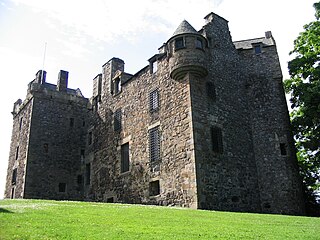Related Research Articles

Earl of Wemyss is a title in the Peerage of Scotland created in 1633. The Scottish Wemyss family had possessed the lands of Wemyss in Fife since the 12th century. Since 1823 the earldom has been held with the Earldom of March, created in 1697. The holder of the title is sometimes known as the Earl of Wemyss and March, but the titles are distinct.
The Battle of Tippermuir was the first battle James Graham, 1st Marquis of Montrose, fought for King Charles I in the Scottish theatre of the Wars of the Three Kingdoms. During the battle, Montrose's Royalist forces routed an army of the Covenanter-dominated Scottish government under John Wemyss, Lord Elcho. The government side took heavy losses.

Francis David Charteris, 12th Earl of Wemyss and 8th Earl of March, styled Lord Elcho from 1916 to 1937, was a Scottish peer, landowner and conservationist. From 1946 to 1991, he served as chairman of the board and then president of the National Trust for Scotland.
William Ruthven, 2nd Lord Ruthven was a Scottish nobleman. He served as an Extraordinary Lord of Session and Keeper of the Privy Seal.

The Clan Ruthven is a Lowland Scottish clan.
Francis Wemyss Charteris was a Scottish landowner who claimed to be 7th Earl of Wemyss.

Francis Richard Charteris, 10th Earl of Wemyss GCVO DL GCVO, styled as Lord Elcho between 1853 and 1883, was a British Whig politician. He founded the Liberty and Property Defence League.

Elcho Castle is located close to the south bank of the River Tay approximately four miles south-east of Perth, Scotland, in the region of Perth and Kinross. It was the maintained by Clan Wemyss from its construction around 1560 until it was put into the care of the Secretary of State for Scotland in the early 20th century, though was not occupied for the entire time. In around 1830 it was re-roofed and a nearby cottage constructed. The castle has been a scheduled monument since 1920 on the grounds of being "a particularly fine example of a Medieval tower-house", and the cottage became a listed building in 1971 in recognition of it's national importance. The castle is unusual in that it has both en suite guest accomodation like a mansion, but also a large number of gun loops.

Clan Moncreiffe is a Highland Scottish clan.

Clan Wemyss is a Lowland Scottish clan.
David Wemyss, 4th Earl of Wemyss was a Scottish peer and Member of Parliament who served as Lord High Admiral of Scotland from 1706 to 1714.

David Wemyss, Lord Elcho and de jure 6th Earl of Wemyss, was a Scottish peer and Jacobite, attainted for his part in the 1745 Rising and deprived of titles and estates.

Kinfauns Castle is a 19th-century castle in the Scottish village of Kinfauns, Perth and Kinross. It is in the Castellated Gothic style, with a slight asymmetry typical of Scottish Georgian. It stands on a raised terrace facing south over the River Tay. The house is protected as a category A listed building, and the grounds are included in the Inventory of Gardens and Designed Landscapes in Scotland.

Clan Kirkpatrick is a Lowland armigerous Scottish clan. There are several variations of the Kirkpatrick name: Kilpatric, Kilpatrick, and Gilpatrick. The names Kirkpatrick and Kilpatrick may have been interchangeable at one time. The clan is recognised by the Court of the Lord Lyon, however the clan does not currently have a chief so recognised. The surname Kirkpatrick is also a recognized sept of Clan Douglas and Clan Colquhoun.
Elcho Priory was a medieval Cistercian priory in Perthshire, Scotland, dedicated to the Virgin Mary.
Francis Wemyss Charteris, Lord Elcho was a Scottish nobleman and Member of Parliament.
Henry Lindsay, 13th Earl of Crawford also known as Harry Charteris, was a Scottish landowner and courtier.

Dorothea Stewart, Countess of Gowrie was a Scottish aristocrat. The dates of the birth and death of Dorothea Stewart are unknown.
References
- ↑ Clan Charteris Profile scotclans.com. Retrieved 24 November 2013.
- 1 2 3 4 5 6 7 8 9 10 11 12 13 14 15 16 17 18 19 20 21 22 23 24 25 26 27 28 29 30 31 32 33 34 35 36 37 38 39 Way, George of Plean; Squire, Romilly of Rubislaw (1994). Collins Scottish Clan & Family Encyclopedia. Glasgow: HarperCollins (for the Standing Council of Scottish Chiefs). pp. 100–101. ISBN 0-00-470547-5.